The Okapi Wildlife Reserve is a UNESCO World Heritage site and one of the largest wildlife conservation areas in the Democratic Republic of Congo. It is found in the north eastern part of DR Congo close to the borders of Uganda and South Sudan. The reserve covers an area of 13,700 square kilometers which is only one-fifth of the great Ituri forest. Among the prominent features in the park include Mount Mbiya, rivers like Ituri, Epulu and Nepoko.
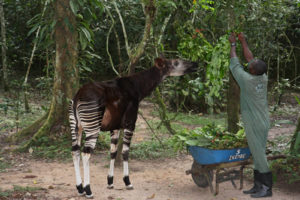 Okapi Wildlife Reserve was created in 1992 to protect the endangered Okapi. It is the only park where one can see Okapi in their natural environment. Besides the Okapi, the reserve is home to 13 species of primates, 101 of mammals and 377 species of birds. Among them include the rare bongo antelopes, 2,000 leopards, forest buffaloes, 8,000 forest elephants, birds, butterflies and other insects. The Ituri forest is home to the last true forest people on earth – The Efe and Mbuti pygmies. Like the Batwa, the pygmies in Ituri forest have lived as forest hunters and gatherers for thousands of years. The presence of the Mbuti pygmies in the forest, makes the Okapi Wildlife Reserve an excellent place to go for guided walks and experience the lives of a true indigenous African tribe. While on a safari in Congo and the reserve in particular, prepare for a true jungle experience including hunting with the pygmies.
Okapi Wildlife Reserve was created in 1992 to protect the endangered Okapi. It is the only park where one can see Okapi in their natural environment. Besides the Okapi, the reserve is home to 13 species of primates, 101 of mammals and 377 species of birds. Among them include the rare bongo antelopes, 2,000 leopards, forest buffaloes, 8,000 forest elephants, birds, butterflies and other insects. The Ituri forest is home to the last true forest people on earth – The Efe and Mbuti pygmies. Like the Batwa, the pygmies in Ituri forest have lived as forest hunters and gatherers for thousands of years. The presence of the Mbuti pygmies in the forest, makes the Okapi Wildlife Reserve an excellent place to go for guided walks and experience the lives of a true indigenous African tribe. While on a safari in Congo and the reserve in particular, prepare for a true jungle experience including hunting with the pygmies.
The Okapi
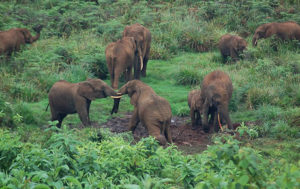 War and insecurity aside, the biodiversity in the Democratic Republic of Congo is second to none in Africa. Congo has rare species like the Okapi, bonobos, mountain and Eastern lowland gorillas. The okapi, sometimes referred to as a forest giraffe or Okapia johnstoni is a strange looking creature with markings on the lake that are similar to that of zebras. What is amazing about the Okapi is that they are more related to giraffes and were only discovered in 1901 at the Virunga National Park. It is only found in the Democratic Republic of Congo in the Ituri forest and Virunga National Park. There are an estimated 5,000 in the Okapi Wildlife reserve alone. Most of them are found in Ituri forest and a few in Virunga National Park.
War and insecurity aside, the biodiversity in the Democratic Republic of Congo is second to none in Africa. Congo has rare species like the Okapi, bonobos, mountain and Eastern lowland gorillas. The okapi, sometimes referred to as a forest giraffe or Okapia johnstoni is a strange looking creature with markings on the lake that are similar to that of zebras. What is amazing about the Okapi is that they are more related to giraffes and were only discovered in 1901 at the Virunga National Park. It is only found in the Democratic Republic of Congo in the Ituri forest and Virunga National Park. There are an estimated 5,000 in the Okapi Wildlife reserve alone. Most of them are found in Ituri forest and a few in Virunga National Park.
Since their official protection in 1933, the Okapi are now classified and listed by the Institute in Congo for the Conservation of Nature (ICCN) as endangered. This new classification is because of their declining numbers in the last 20 years. The government of Congo has selected the Okapi as a national symbol of wildlife conservation and appears in many national emblems.
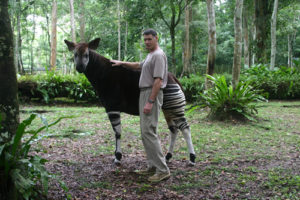 For the Okapi and other creatures in the reserve to thrive, they need large and dense forests. The greatest threat to the Okapi and the reserve is forest encroachment by migrants from overpopulated parts of Eastern Congo, poaching for bush meat, illegal logging, illegal gold and Coltan mining. The unpredictable security situation and lack of political stability in the Eastern part of Congo makes protecting the Okapi and the reserve challenging. In 2012, the Mai-Mai militia attracted the park offices in Epulu leaving six people and 13 Okapi dead. More recently in 2015, the guard post in Zunguluka was attacked and burnt. Most of these attacks are in retaliation by the militias for the good work done by the government forces and the Okapi Conservation Project in fighting poachers and illegal miners in the Reserve.
For the Okapi and other creatures in the reserve to thrive, they need large and dense forests. The greatest threat to the Okapi and the reserve is forest encroachment by migrants from overpopulated parts of Eastern Congo, poaching for bush meat, illegal logging, illegal gold and Coltan mining. The unpredictable security situation and lack of political stability in the Eastern part of Congo makes protecting the Okapi and the reserve challenging. In 2012, the Mai-Mai militia attracted the park offices in Epulu leaving six people and 13 Okapi dead. More recently in 2015, the guard post in Zunguluka was attacked and burnt. Most of these attacks are in retaliation by the militias for the good work done by the government forces and the Okapi Conservation Project in fighting poachers and illegal miners in the Reserve.
The continued migrations of people from other parts of the country into the reserve area is arguably the greatest threat to the Okapi Wildlife Reserve. Whereas the pygmy tribes have learnt how to live in harmony with nature by taking only what is enough, immigrants are the ones responsible for deforestation and excessive poaching.
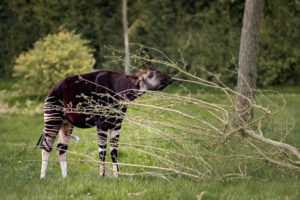 Between 1996 and 1998, rebel activity in the reserve reduced the overall population of forest elephants in the park. At that time trade in ivory was very lucrative in Congo (It still is but risky these days). The plight of the elephants caught the attention of wildlife conservation organizations around the world. Funds were made available and operation Tango was initiated to halt the destruction of the elephants and protect areas which the Congolese authorities couldn’t reach. This operation was very successful and created stability in the reserve that still exists to this day. This operation also showed that the future of the reserve depends on the support of international partners. The Okapi Conservation project, Epulu Conservation and Research Center are key establishments as we shall see in the next paragraph.
Between 1996 and 1998, rebel activity in the reserve reduced the overall population of forest elephants in the park. At that time trade in ivory was very lucrative in Congo (It still is but risky these days). The plight of the elephants caught the attention of wildlife conservation organizations around the world. Funds were made available and operation Tango was initiated to halt the destruction of the elephants and protect areas which the Congolese authorities couldn’t reach. This operation was very successful and created stability in the reserve that still exists to this day. This operation also showed that the future of the reserve depends on the support of international partners. The Okapi Conservation project, Epulu Conservation and Research Center are key establishments as we shall see in the next paragraph.
The Okapi Conservation Project
Okapi Wildlife Reserve was created by the Okapi Conservation Project in collaboration with the government of Congo. Currently headed by John Lukas, the Okapi Conservation Project assists and sustains the work of ICCN to protect, secure and manage most of the affairs of the Okapi Wildlife Reserve. The project was created in 1987 (earlier than the Okapi Wildlife Reserve itself) and has worked to protect indigenous pygmies and endangered Okapi at reserve. Although the Okapi is the main focus of the project, other species like chimpanzees and the forest elephants have benefited from the conservation efforts in the reserve. The project started a research and breeding station with about 14 Okapis called the Epulu Conservation and Research Centre.
The work of the Okapi Conservation Project depends on outreach activities, wildlife educational programmes and assistance to the community. The project also helps educate communities living within and outside the reserve to have an understanding of the importance of the Okapi Wildlife Reserve. The project has invested in building he capacity of its local staff, Guards and local communities living outside the reserve to sufficiently support their mission. One of the significant achievements of the project is to provide housing facilities and healthcare for rangers working in the reserve and their families. The project also takes care of all administrative costs in the reserve including fuel, office supplies, patrols, uniforms, boots and communication equipment like satellite phones.
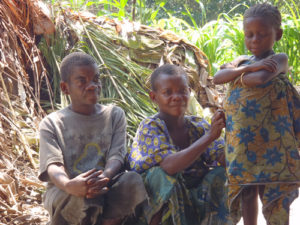 In order to curb poaching, illegal logging and mining, the project has also helped set up a well-organized intelligence network involving the pygmies and communities living close to the reserve. They have managed to convince the pygmies and nearby communities that they are on their said hence gaining their trust. Because of the good working relationship with the local communities, the project has helped set up hospital (including ambulances), schools and water sources in the region. They also help local farmers in using advanced agricultural methods to improve their annual yields. A fund has been set up by the project to take care of families of deceased rangers.
In order to curb poaching, illegal logging and mining, the project has also helped set up a well-organized intelligence network involving the pygmies and communities living close to the reserve. They have managed to convince the pygmies and nearby communities that they are on their said hence gaining their trust. Because of the good working relationship with the local communities, the project has helped set up hospital (including ambulances), schools and water sources in the region. They also help local farmers in using advanced agricultural methods to improve their annual yields. A fund has been set up by the project to take care of families of deceased rangers.
It is important to note that despite the above achievements by the Okapi Wildlife Reserve, sustainability depends on good and strong leadership in the Democratic Republic of Congo. With the conclusion of the recent presidential elections, there is high hope that a new chapter has started in the country and massive political reforms will start a clear roadmap to peace and prosperity in all parts of the country.
Main Activities at the Okapi Wildlife Reserve
Viewing Wildlife: As already noted earlier, Okapi Wildlife Reserve is not all about the Okapi’s. It has a variety of other wildlife which makes for truly fascinating wildlife encounters for those who are lucky to visit it. The reserve is home to Chimpanzees, leopards, giant forest hogs, elephants, water chevrotain, forest buffaloes, giant pangolins, golden cats, pygmy antelopes, forest genet, Anubis baboons, several other antelope species and the African dwarf crocodiles among many other species.
Birding: The Okapi Wildlife Reserve is one of the best birding spots in the Democratic Republic of Congo. The reserve is home to 370 recorded species. The prominent species are the vultures and herons.
A cultural encounter and a chance to hunt with the Mbuti Pygmies: If you are the type who cannot imagine an African safari without visiting one of its indigenous tribes, then the Okapi Wildlife Reserve will not disappoint you. Mbuti pygmies are short in stature when compared to their bantu neighbors living outside the reserve. They are primitive people whose lives have not been disturbed much by modern civilization. Just like the Batwa pygmies in Uganda, the Mbuti and Efe pygmies have 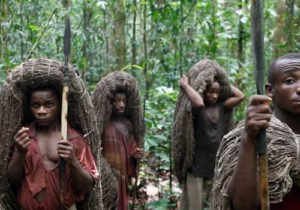 lived in the Ituri forest for thousands of years as forest hunters and gatherers. When not hunting, the pygmies gather honey, insects, seeds, fungi and plants. They are masters at identifying wild plants for medical purposes. Whereas most of the Batwa were evicted from the forests to create room for mountain gorillas, the pygmies in Okapi Wildlife Reserve still live happily in the Ituri forest undisturbed. The pygmies have great respect for the forest and its creatures. It is why it has been easy to work with them and leave them to their ancient ways of life. The pygmies have always lived in harmony with their bantu neighbors. They exchange game meat for cereals and other starch foods in order to have a more balanced diet.
lived in the Ituri forest for thousands of years as forest hunters and gatherers. When not hunting, the pygmies gather honey, insects, seeds, fungi and plants. They are masters at identifying wild plants for medical purposes. Whereas most of the Batwa were evicted from the forests to create room for mountain gorillas, the pygmies in Okapi Wildlife Reserve still live happily in the Ituri forest undisturbed. The pygmies have great respect for the forest and its creatures. It is why it has been easy to work with them and leave them to their ancient ways of life. The pygmies have always lived in harmony with their bantu neighbors. They exchange game meat for cereals and other starch foods in order to have a more balanced diet.
With permission from the park authorities, the pygmies will take you out into the forest to hunt for forest birds and mammals. Their favorite animals are antelopes and primates. They use bows and arrows to hunt wild game and catch fish using fiber nets or arrows. Moving with the pygmies is the best to spot the rare Okapi because the pygmies know how to find them using mysterious clues. The pygmies know how to identify most of the plants and animals by carefully studying the signs left behind. After visiting the pygmies, you can also visit their bantu neighbors to see contrasts in lifestyle.
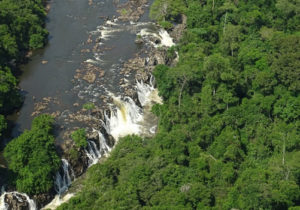 Nature Walks: Guided Nature walks can be arranged to some of the best locations within the forest. Okapi Wildlife Reserve like many national parks of the Democratic Republic of Congo is still blessed with pristine wilderness that has not been discovered or visited by many. The remoteness and poor road networks has helped keep some of the reserves and national parks in Congo isolated and hence well preserved. While at the Okapi Wildlife Reserve, you can climb to the top of Mount Mbeya or visit the beautiful rivers of Nepoko. The Ituri forest has some of the most beautiful waterfalls you will ever see.
Nature Walks: Guided Nature walks can be arranged to some of the best locations within the forest. Okapi Wildlife Reserve like many national parks of the Democratic Republic of Congo is still blessed with pristine wilderness that has not been discovered or visited by many. The remoteness and poor road networks has helped keep some of the reserves and national parks in Congo isolated and hence well preserved. While at the Okapi Wildlife Reserve, you can climb to the top of Mount Mbeya or visit the beautiful rivers of Nepoko. The Ituri forest has some of the most beautiful waterfalls you will ever see.
Camping: Visiting the remote parts of Congo and the Okapi Wildlife Reserve in particular is for those who are very adventurous and wish to experience something out of the ordinary. Something truly unique that they can tell those friends of yours who are more comfortable with the more known African safari destinations. Camping in the Okapi Wildlife Reserve will give you that rare filling of being out in true African wilderness. The best camping sites are at the shores of river Epulu.
Visiting the Okapi Wildlife Reserve – What you need to know
The Okapi Wildlife Reserve is currently visited by very adventurous tourists who know that in order to experienced something special, you need to take risks. And by risk, I mean deciding to travel to Congo even when there is a lot of bad press about the country out there. Deciding to go or it even when there is an Ebola outbreak or even when news comes out of rebel activity or a kidnapping. These brave travelers know that people are living in these countries and that they will find many international travelers like them willing to take the risk. In fact, the chances of contracting Ebola or getting caught in rebel crossfire is so small that you wonder why we can’t take the risk. Are you willing to take the same risk like many other are doing?
When is the best time for visiting the Okapi Wildlife Reserve? The Okapi Wildlife Reserve is technically opened for visitors throughout the year but the dry seasons between June and August is perfect for visiting. Caution must be exercised before visiting the park and you need an update of the security situation from the Okapi Conservation Project or your tour company before traveling to the Okapi Wildlife Reserve
As already noted earlier, the Okapi Wildlife Reserve is found in the north-eastern border of the DR Congo, close to the border between Uganda and Congo. The closest town to the reserve is Isiro. If you are visiting the Centre, you need to leave from Isiro (nearest town), Kisangani or Beni and stop at the town of Epalu. If you are leaving from Beni or Kisangani by road, you need to reserve a full day of traveling and another for returning. You will need a good four-wheel drive which is in good mechanical condition (with spare tires) especially during the rainy season. Travelers can also book chartered flights from the airport in Bunia or Goma after arriving from Kinshasa or Kigali in Rwanda.
Entrance to the park is free but accommodation isn’t. You would need to arrange your own accommodation while visiting the reserve. The best place to stay is at the reserve headquarters in Epulu. They have their own accommodation facilities but with few rooms during certain periods of the year. Other hotels close to the Reserve are plaza hotel, Immo Baje, Hotel Kisangani, Vuvuke guest house and plaza hotel.

I am very interested in visiting the Ituri forest, the rare animals and the natives that live there – especially the Efe Pygmies. I have dreamed of this since I was young. I am now 70. I have been to South Africa, Botswana, Zimbabwe and Victoria Falls on a safari. I’ve been discouraged many times of going to equatorial Africa (Congo) due to many dangers and unrest. I just finished reading the Congo Kitabu and Pygmy Kitabu. This reading has stirred up my dream of going to Africa’s Ituri Forest in the Congo. I love the jungle, animals and native people. Do you think this is too dangerous for me, a tall white American at age of 70 (in good health)? Possibly to plan for 2023?
I’m thinking the same myself. I’m a 74 year old white Australian female. I’ve stayed three times in Kruger National Park and loved it but have always dreamed of visiting the Congo.
Dear Ronda,
warm greetings from Mission Africa Safaris. The Democratic Republic of Congo is one of the last places to experience the pristine wilderness of Africa. Go there and expect beautiful unspoiled scenery, unique cultures, mountain gorillas, Eastern lowland gorillas, the rare Okapi, peacocks and so much more. In future, many people will visit this naturally beautiful country.
I would love to visit Ituri National Park and see the Okapis. Do you offer Trips for small Group (2-4 persons)? Do you also arrange tours to encounter Bonobos? I know its far away. Thanks you for your Feedback. Kind regards, Peter Schmid